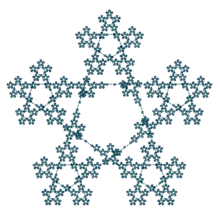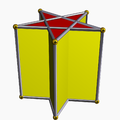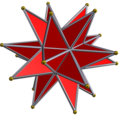Dark Drawing of 5 Point Star in Circle
| Regular pentagram | |
|---|---|
 A regular pentagram | |
| Blazon | Regular star polygon |
| Edges and vertices | 5 |
| Schläfli symbol | {v/2} |
| Coxeter–Dynkin diagrams | |
| Symmetry grouping | Dihedral (D5) |
| Internal bending (degrees) | 36° |
| Backdrop | star, circadian, equilateral, isogonal, isotoxal |
A pentagram (sometimes known as a pentalpha, pentangle, or star pentagon) is the shape of a 5-pointed star polygon whose collinear edges accept been connected with intersecting lines. Cartoon a circle around the 5 points creates a similar symbol referred to every bit the pentacle, which is used widely by Wiccans, pagans, or just as a sign of life and connections. The discussion "pentagram" refers only to the five-pointed star, not the circumvolve surrounding it in a pentacle.
Pentagrams were used symbolically in ancient Greece and Babylonia, today they are widely used by the Wicca, witches, and pagans, akin to the use of the cross past Christians. The pentagram has magical associations. Many people who practice Modern Paganism and Pagan faiths wear jewelry incorporating the symbol. Christians once unremarkably used the pentagram to stand for the five wounds of Jesus.
The word pentagram comes from the Greek word πεντάγραμμον (pentagrammon),[1] from πέντε (pente), "five" + γραμμή (grammē), "line".[ii] Pentagram refers to just the star and pentacle refers to the star inside the circle specifically although these are often referred to equally the same.[3] The word pentalpha is a learned modern (17th-century) revival of a post-classical Greek name of the shape.[four]
History [edit]
Early history [edit]

A Pythagorean "Hugieia Pentagram"[5]
Early pentagrams have been found on Sumerian pottery from Ur circa 3500 BCE,[6]and the five-pointed star was at various times the symbol of Ishtar or Marduk.[7] [viii]
The pentagram was known to the ancient Greeks, with a depiction on a vase maybe dating back to the 7th century BC.[9] Pythagoreanism originated in the 6th century BC and used the pentagram as a symbol of mutual recognition and of wellbeing.[ten]
From around 300-150 BCE the pentagram stood as the symbol of Jerusalem, marked by the 5 Hebrew messages ירשלם spelling its proper name.[11]
The word Pentemychos ( πεντέμυχος lit. "five corners" or "v recesses")[12] was the title of the cosmogony of Pherecydes of Syros.[13] Here, the "five corners" are where the seeds of Chronos are placed within the Globe in club for the creation to appear.[14] [ clarification needed ]
In Neoplatonism, the pentagram was said to take been used as a symbol or sign of recognition by the Pythagoreans, who chosen the pentagram ὑγιεία hugieia "health"[fifteen]
Western symbolism [edit]
Heart Ages [edit]
The pentagram was used in ancient times as a Christian symbol for the v senses,[16] or of the five wounds of Christ. The pentagram plays an of import symbolic role in the 14th-century English poem Sir Gawain and the Green Knight, in which the symbol decorates the shield of the hero, Gawain. The unnamed poet credits the symbol's origin to King Solomon, and explains that each of the five interconnected points represents a virtue tied to a group of 5: Gawain is perfect in his five senses and five fingers, faithful to the 5 Wounds of Christ, takes courage from the 5 joys that Mary had of Jesus, and exemplifies the five virtues of knighthood,[17] which are generosity, friendship, chastity, knightly, and piety.[18]

The N rose of Amiens cathedral (built in the 13th century) exhibits a pentagram-based motif. Some sources interpret the unusual downward-pointing star as symbolizing the Holy Spirit descending on people.
Renaissance [edit]
Heinrich Cornelius Agrippa and others perpetuated the popularity of the pentagram every bit a magic symbol, attributing the five neoplatonic elements to the five points, in typical Renaissance fashion.
Romanticism [edit]
By the mid-19th century, a further distinction had developed amongst occultists regarding the pentagram'southward orientation. With a single point upwardly it depicted spirit presiding over the iv elements of matter, and was essentially "good". However, the influential writer Éliphas Lévi called it evil whenever the symbol appeared the other way upwardly.
- "A reversed pentagram, with two points projecting upwards, is a symbol of evil and attracts sinister forces because it overturns the proper order of things and demonstrates the triumph of thing over spirit. It is the caprine animal of animalism attacking the heavens with its horns, a sign execrated past initiates."[xix]
- "The flaming star, which, when turned upside downwardly, is the heirolgyphic [sic] sign of the goat of blackness magic, whose head may be drawn in the star, the two horns at the height, the ears to the right and left, the bristles at the lesser. Information technology is a sign of antagonism and fatality. Information technology is the goat of lust attacking the heavens with its horns."[20]
- "Let us keep the effigy of the 5-pointed Star e'er upright, with the topmost triangle pointing to heaven, for information technology is the seat of wisdom, and if the effigy is reversed, perversion and evil will be the consequence."[21]
-
Some other pentagram from Agrippa'south book. This one has the Pythagorean messages inscribed around the circumvolve.
The apotropaic use of the pentagram symbol in German folklore (called Drudenfuss in German) is referred to by Goethe in Faust (1808), where a pentagram prevents Mephistopheles from leaving a room (but did not prevent him from entering by the same style, as the outward pointing corner of the diagram happened to be imperfectly drawn):
Mephistopheles:
- I must confess, I'thousand prevented though
- By a little thing that hinders me,
- The Druid's-foot on your doorsill–
Faust:
- The Pentagram gives you hurting?
- So tell me, y'all Son of Hell,
- If that's the example, how did you proceeds
- Entry? Are spirits similar yous cheated?
Mephistopheles:
- Look carefully! It'southward not completed:
- One angle, if you audit it closely
- Has, as you lot see, been left a little open.[22]
Due east Asian symbolism [edit]

Wu Xing (Chinese: 五行; pinyin: Wǔ Xíng ) are the five phases, or five elements in Taoists Chinese tradition. They are differentiated from the formative ancient Japanese or Greek elements, due to their emphasis on cyclic transformations and change. The five phases are: Burn down (火 huǒ), Earth (土 tǔ), Metallic (金 jīn), Water (水 shuǐ), and Wood (木 mù). The Wuxing is the key philosophy and doctrine of traditional Chinese Medicine and Acupuncture.[23]
Uses in modern occultism [edit]
Based on Renaissance-era occultism, the pentagram constitute its way into the symbolism of modern occultists. Its major use is a continuation of the aboriginal Babylonian utilize of the pentagram as an apotropaic charm to protect against evil forces.[24] Éliphas Lévi claimed that "The Pentagram expresses the heed's domination over the elements and it is by this sign that we bind the demons of the air, the spirits of burn, the spectres of water, and the ghosts of earth."[25] In this spirit, the Hermetic Guild of the Gilt Dawn developed the use of the pentagram in the lesser banishing ritual of the pentagram, which is all the same used to this 24-hour interval past those who practice Golden Dawn-blazon magic.
Aleister Crowley made utilise of the pentagram in his Thelemic system of magick: an adverse or inverted pentagram represents the descent of spirit into matter, according to the interpretation of Lon Milo DuQuette.[26] Crowley contradicted his one-time comrades in the Hermetic Order of the Golden Dawn, who, following Levi, considered this orientation of the symbol evil and associated it with the triumph of matter over spirit.
Use in new religious movements [edit]
Baháʼí Faith [edit]
The five-pointed star is a symbol of the Baháʼí Faith.[27] [28] In the Baháʼí Faith, the star is known every bit the Haykal (Arabic: "temple"), and it was initiated and established past the Báb. The Báb and Bahá'u'lláh wrote various works in the form of a pentagram.[29] [30]
-

Haykal past the Báb written in his ain hand.
-

An unidentified work of the Báb.
-

An unidentified piece of work of the Báb.
The Church of Jesus Christ of Latter-day Saints [edit]
The Church of Jesus Christ of Latter-day Saints is theorized to take began using both upright and inverted five-pointed stars in Temple architecture, dating from the Nauvoo Illinois Temple defended on 30 April 1846.[31] Other temples decorated with five-pointed stars in both orientations include the Salt Lake Temple and the Logan Utah Temple. These usages come from the symbolism establish in Revelation chapter 12: "And there appeared a great wonder in heaven; a woman clothed with the sun, and the moon under her feet, and upon her head a crown of twelve stars."[32]
Wicca [edit]

Typical Neopagan pentagram (circumscribed)

USVA headstone emblem 37
Because of a perceived association with Satanism and occultism, many U.s.a. schools in the late 1990s sought to preclude students from displaying the pentagram on clothing or jewelry.[33] In public schools, such actions by administrators were determined in 2000 to be in violation of students' Offset Amendment right to free exercise of religion.[34]
The encircled pentagram (referred to as a pentacle by the plaintiffs) was added to the list of 38 approved religious symbols to be placed on the tombstones of fallen service members at Arlington National Cemetery on 24 April 2007. The decision was fabricated post-obit 10 applications from families of fallen soldiers who adept Wicca. The government paid the families US$225,000 to settle their pending lawsuits.[35] [36]
Other religious use [edit]
Serer religion [edit]


Representation of the three worlds in Serer cosmogony: the invisible globe, the terrestrial world and the nocturnal world.[39]
The five-pointed star is a symbol of the Serer faith and the Serer people of West Africa. Called Yoonir in their language, it symbolizes the universe in the Serer creation myth, and also represents the star Sirius.[37] [38]
Judaism [edit]
The pentagram has been used in Judaism since at least 300BCE when information technology first was used equally the stamp of Jerusalem. It is used to stand for justice, mercy, and wisdom.
Other modern use [edit]
- The pentagram is featured on the national flags of Morocco (adopted 1915) and Federal democratic republic of ethiopia (adopted 1996 and readopted 2009)
- The Order of the Eastern Star, an organization (established 1850) associated with Freemasonry, uses a pentagram as its symbol, with the 5 isosceles triangles of the points colored blue, yellow, white, green, and red. In well-nigh Grand Capacity the pentagram is used pointing down, but in a few, information technology is pointing up. Thou Chapter officers often accept a pentagon inscribed around the star[40](the keepsake shown here is from the Prince Hall Clan).
- A pentagram is featured on the flag of the Dutch urban center of Haaksbergen, as well on its coat of arms.
-

Flag of Haaksbergen
- A pentagram is featured on the flag of the Japanese city of Nagasaki, as well on its emblem.
-

Flag of Nagasaki
Geometry [edit]


The pentagram is the simplest regular star polygon. The pentagram contains ten points (the v points of the star, and the five vertices of the inner pentagon) and fifteen line segments. It is represented by the Schläfli symbol {v/ii}. Like a regular pentagon, and a regular pentagon with a pentagram constructed inside it, the regular pentagram has as its symmetry group the dihedral grouping of order 10.
It tin be seen as a net of a pentagonal pyramid although with isosceles triangles.
Structure [edit]
The pentagram can exist constructed past connecting alternating vertices of a pentagon; meet details of the construction. It can likewise be constructed as a stellation of a pentagon, by extending the edges of a pentagon until the lines intersect.
Truncation [edit]
A compatible truncated pentagram t{5/2} produces a doubly-wrapped pentagon with overlapping vertices and edges, {10/2}. A shallower truncation produces an isogonal figure, like this ane with equally spaced vertices. A truncated retro-pentagram t{5/three}, or a quasitruncation, produces a decagram, {10/three}.
Gilt ratio [edit]

A regular pentagram colored to distinguish its line segments of unlike lengths. The 4 lengths are in gilt ratio to one some other.
The golden ratio, φ = (1 + √5 ) / 2 ≈ 1.618, satisfying
plays an important role in regular pentagons and pentagrams. Each intersection of edges sections the edges in the aureate ratio: the ratio of the length of the edge to the longer segment is φ, as is the length of the longer segment to the shorter. Also, the ratio of the length of the shorter segment to the segment bounded by the 2 intersecting edges (a side of the pentagon in the pentagram's heart) is φ. As the iv-color illustration shows:
The pentagram includes ten isosceles triangles: v astute and five obtuse isosceles triangles. In all of them, the ratio of the longer side to the shorter side is φ. The acute triangles are golden triangles. The obtuse isosceles triangle highlighted via the colored lines in the analogy is a golden gnomon.
Trigonometric values [edit]
As a upshot, in an isosceles triangle with ane or two angles of 36°, the longer of the two side lengths is φ times that of the shorter of the 2, both in the case of the acute equally in the instance of the birdbrained triangle.
Spherical pentagram [edit]
A pentagram can be fatigued as a star polygon on a sphere, equanimous of five great circle arcs, whose all internal angles are right angles. This shape was described by John Napier in his 1614 volume Mirifici logarithmorum canonis descriptio (Description of the wonderful rule of logarithms) along with rules that link the values of trigonometric functions of five parts of a right spherical triangle (two angles and iii sides). It was studied later by Carl Friedrich Gauss.
Three-dimensional figures [edit]
Several polyhedra contain pentagrams:
College dimensions [edit]
Orthogonal projections of higher dimensional polytopes can also create pentagrammic figures:
| 4D | 5D | ||
|---|---|---|---|
 The regular five-cell (four-simplex) has five vertices and 10 edges. |  The rectified v-cell has x vertices and 30 edges. |  The rectified 5-simplex has 15 vertices, seen in this orthogonal projection as three nested pentagrams. |  The birectified 5-simplex has 20 vertices, seen in this orthogonal projection as four overlapping pentagrams. |
All ten 4-dimensional Schläfli–Hess four-polytopes have either pentagrammic faces or vertex figure elements.
Pentagram of Venus [edit]

The pentagram of Venus is the apparent path of the planet Venus as observed from Earth. Successive inferior conjunctions of Venus repeat with an orbital resonance of approximately 13:8—that is, Venus orbits the Sun approximately 13 times for every viii orbits of Earth—shifting 144° at each inferior conjunction.[42] The tips of the 5 loops at the eye of the effigy have the aforementioned geometric relationship to one some other as the five vertices, or points, of a pentagram, and each group of five intersections equidistant from the figure's center take the same geometric relationship.
In computer systems [edit]
The pentagram has these Unicode lawmaking points that enable them to be included in documents:
- U+26E4 ⛤ PENTAGRAM
- U+26E5 ⛥ RIGHT-HANDED INTERLACED PENTAGRAM
- U+26E6 ⛦ LEFT-HANDED INTERLACED PENTAGRAM
- U+26E7 ⛧ INVERTED PENTAGRAM
Come across as well [edit]
- Christian symbolism – Use of symbols, including archetypes, acts, artwork or events, past Christianity
- Control at Sea insignia
- Enneagram (geometry) – Star polygon
- Five-pointed star – Geometrically a regular concave decagon, is a common ideogram in mod civilisation
- Heptagram – Star polygon
- Hexagram – Six-pointed star polygon
- Lute of Pythagoras – Self-similar geometric figure
- Medal of Honour – Highest award in the United States military machine
- Pentachoron – the 4-simplex
- Pentagram map – Discrete dynamical organisation on the moduli space of polygons in the projective plane
- Pentalpha – Puzzle involving stones and a pentagram
- Petersen graph – Cubic graph with 10 vertices and xv edges
- Ptolemy's theorem – Relates the 4 sides and two diagonals of a quadrilateral with vertices on a common circle
- Seal of Solomon – Signet ring attributed to Male monarch Solomon of Israel in Islamic and Jewish mysticism
- Star polygons in art and culture – Polygons as symbolic elements
- Star (heraldry) – In heraldry, any pierced or unpierced star-shaped charge with whatsoever number of straight or wavy rays
- Stellated polygons – Extending the elements of a polytope to course a new figure
References [edit]
- ^ πεντάγραμμον, Henry George Liddell, Robert Scott, A Greek-English Dictionary, on Perseus; a substantive grade of adjectival πεντάγραμμος (pentagrammos) or πεντέγραμμος (pentegrammos), a word meaning roughly "5-lined" or "5 lines"
- ^ πέντε, Henry George Liddell, Robert Scott, A Greek-English Lexicon, on Perseus; Satan all 3 names mentioned earlier daylight full γραμμή, Henry George Liddell, Robert Scott, A Greek-English Lexicon, on Perseus
- ^ this usage is borne out by the Oxford English Lexicon, although that work specifies that a circumscription makes the form of a five-pointed star and its etymon post-classical Latin pentaculum [...] A pentagram, esp. ane enclosed in a circle; a talisman or magical symbol in the shape of or inscribed with a pentagram. Also, in extended employ: any like magical symbol (freq. practical to a hexagram formed by two intersecting or interlaced equilateral triangles)."
- ^ πένταλϕα, "five Alphas", interpreting the shape as five Α shapes overlapping at 72-degree angles.
- ^ Allman, Chiliad. J., Greek Geometry From Thales to Euclid (1889), p.26.
- ^ "History of the Pentagram — D. J. Scott'due south Oldschool Website". djonscott.com.
- ^ Budge, Sir East. A. Wallis (1968). Amulets and Talismans. p. 433.
- ^ Scott, Dustin Jon (2006). "History of the Pentagram". Retrieved xviii May 2021.
- ^ Coxeter, H.S.M.; Regular Polytopes, third edn, Dover, 1973, p. 114.
- ^ Brawl, W. Westward. Rouse and Coxeter, H. Due south. Yard.; Mathematical Recreations and Essays, 13th Edn., Dover, 1987, p. 249.
- ^ "Star of David vs. Pentagram: Everything You Need to Know". 17 July 2020.
- ^ πεντέμυχος, Henry George Liddell, Robert Scott, A Greek-English language Dictionary, on Perseus
- ^ This is a lost book, but its contents are preserved in Damascius, De principiis, quoted in Kirk and Raven, (1983) [1956], p. 55.
- ^ "the divine products of Chronos' seed, when tending in 5 recesses, were called πεντέμυχος (Pentemychos)" Kirk, Geoffrey Stephen; Raven, John Earle; Schofield, Malcolm (1983) [1957]. The Presocratic Philosophers: A Disquisitional History with a Selection of Texts (2nd, illustrated, revised, reprint ed.). Cambridge University Press. pp. 51–52, 55. ISBN978-0-521-27455-5.
the only other identify in Homer where Ortygie [sic] is mentioned is Odyssey Five, 123, where Orion, having been carried off by Eos [the dawn], is slain... by Artemis... since solstices would usually exist observed at sunrise in summer, and then in the northward-east-by-east direction, that is what the phrase might suggest... the dwelling-place of Eos... Aia..
- ^ Allman, 1000. J., Greek Geometry From Thales to Euclid, function I (1877), in Hermathena 3.5, pp. 183, 197, citing Iamblichus and the Scholiast on Aristophanes. The pentagram was said to have been then chosen from Pythagoras himself having written the letters Υ, Γ, Ι, Θ (= /ei/), Α on its vertices.
- ^ Christian Symbols Ancient and Modern, Kid, Heather and Dorothy Colles. New York: Charles Scribner's Sons, 1971, ISBN 0-7135-1960-vi.
- ^ Morgan, Gerald (1979). "The Significance of the Pentangle Symbolism in "Sir Gawain and the Green Knight"". The Modern Language Review. 74 (4): 769–790. doi:10.2307/3728227. JSTOR 3728227.
- ^ Sir Gawain and the Greenish Knight, lines 619–665
- ^ Lévi, Éliphas (1999) [1896 (translated), 1854 (offset published)]. Transcendental Magic, its Doctrine and Ritual [Dogme et rituel de la haute magie]. Trans. by A. E. Waite. York Beach: Weiser. OCLC 263626874.
- ^ Lévi, Éliphas (2002) [1939 (translated), 1859 (beginning published)]. The Key of the Mysteries [la Clef des grands mystères suivant Hénoch, Abraham, Hermès Trismégiste et Salomon]. Trans. by Aleister Crowley. Boston: Weiser. p. 69. OCLC 49053462.
- ^ Hartmann, Franz (1895) [1886]. Magic, White and Blackness (5th ed.). New York: The Path. OCLC 476635673.
- ^ "Goethe, Johann Wolfgang von (1749–1832) - Faust, Part I: Scenes I to III". www.poetryintranslation.com . Retrieved 25 May 2021.
- ^ Chen, Yuan Julian (2014). ""Legitimation Discourse and the Theory of the V Elements in Purple China." Journal of Song-Yuan Studies 44 (2014): 325-364". Journal of Song-Yuan Studies. 44 (1): 325–364. doi:x.1353/sys.2014.0000. S2CID 147099574.
- ^ Schouten, Jan (1968). The Pentagram as Medical Symbol: An Iconological Study. Hes & De Graaf. p. 18. ISBN978-90-6004-166-six.
- ^ Waite, Arthur Edward (1886). The Mysteries of Magic: A Digest of the Writings of Eliphas Lévi. London: George Redway. p. 136.
- ^ DuQuette, Lon Milo (2003). The Magick of Aleister Crowley: A Handbook of the Rituals of Thelema. Weiser Books. pp. 93, 247. ISBN978-1-57863-299-two.
- ^ "Bahá'í Reference Library - Directives from the Guardian, Pages 51-52". reference.bahai.org.
- ^ "The 9-Pointed Star". bahai-library.com.
- ^ Moojan Momen (2019). The Star Tablet of the Bab. British Library Blog.
- ^ Bayat, Mohamad Ghasem (2001). An Introduction to the Súratu'l-Haykal (Discourse of The Temple) in Lights of Irfan, Book 2.
- ^ See the Nauvoo Temple Archived 17 May 2020 at the Wayback Machine website discussing its architecture, and especially the page on Nauvoo Temple outside symbolism Archived 17 May 2020 at the Wayback Machine. Retrieved 16 December 2006.
- ^ Brown, Matthew B (2002). "Inverted Stars on LDS Temples" (PDF). FAIRLDS.org. Archived from the original (PDF) on 29 February 2008.
- ^ "Religious Clothing in School", Robinson, B.A., Ontario Consultants on Religious Tolerance, 20 August 1999, updated 29 April 2005. Retrieved 10 February 2006. "ACLU Defends Honor Educatee Witch Pentacle" (Press release). American Civil Liberties Spousal relationship of Michigan. 10 Feb 1999. Archived from the original on 8 November 2003. Retrieved 10 February 2006.
{{cite press release}}: CS1 maint: bot: original URL condition unknown (link) "Witches and wardrobes: Male child says he was suspended from school for wearing magical symbol" Rouvalis, Cristina; Pittsburgh Mail service-Gazette, 27 September 2000. Retrieved x February 2006. - ^ "Federal judge upholds Indiana students' correct to wear Wiccan symbols". Associated Press. ane May 2000. Archived from the original on 30 March 2014. Retrieved 21 September 2007.
{{cite web}}: CS1 maint: bot: original URL condition unknown (link) - ^ "Wiccan symbol OK for soldiers' graves". CNN.com. Associated Printing. 23 April 2007. Archived from the original on 26 April 2007.
- ^ "Burial and Memorials: Available Emblems of Belief for Placement on Authorities Headstones and Markers". United states Section of Veterans Diplomacy. iii July 2013. Retrieved thirteen January 2014.
- ^ a b Gravrand 1990, p. xx.
- ^ a b Madiya, Clémentine Faïk-Nzuji (1996). Tracing Memory: A Glossery of Graphic Signs and Symbols in African Art and Civilization. Mercury serial, no. 71. Hull, Québec: Canadian Museum of Civilization. pp. 27, 155. ISBN0-660-15965-1.
- ^ Gravrand 1990, p. 216.
- ^ Ritual of the Order of the Eastern Star, 1976
- ^ Pietrocola, Giorgio (2005). "Tartapelago. Exposure of fractals". Maecla.
- ^ Baez, John (4 Jan 2014). "The Pentagram of Venus". Azimuth. Archived from the original on 14 December 2015. Retrieved 7 January 2016.
Bibliography [edit]
- Becker, Udo (1994). "Pentagram". The Continuum Encyclopedia of Symbols. Translated by Garmer, Lance Westward. New York City: Continuum Books. p. 230. ISBN978-0-8264-0644-6.
- Conway, John Horton; Burgiel, Heidi; Goodman-Strauss, Chaim (April 2008). "Chapter 26, Higher Still: Regular Star-Polytopes". The Symmetries of Things. Wellesley, Massachusetts: A. One thousand. Peters. p. 404. ISBN978-i-56881-220-5.
- Ferguson, George Wells (1966) [1954]. Signs and Symbols in Christian Art. New York Urban center: Oxford University Press. p. 59. OCLC 65081051.
- Gravrand, Henry (Jan 1990). La civilisation Sereer, Volume 2: Pangool. Nouvelles éditions Africaines du Sénégal (in French). Dakar, Senegal. ISBNtwo-7236-1055-ane.
- Grünbaum, Branko; Shephard, Geoffrey Colin (1987). Tilings and Patterns. New York: W. H. Freeman. ISBN978-0-7167-1193-3.
- Grünbaum, Branko (1994). "Polyhedra with Hollow Faces". In Bisztriczky, T.; McMullen, P.; Schneider, A.; Weiss, A. Ivić (eds.). Polytopes: Abstruse, Convex and Computational. NATO ASI Series C: Mathematical and Physical Sciences. Vol. 440. Dordrecht: Springer Netherlands. pp. 43–seventy. doi:10.1007/978-94-011-0924-6_3. ISBN978-94-010-4398-4.
External links [edit]
| | Wikimedia Commons has media related to Pentagrams. |
- Weisstein, Eric W. "Pentagram". MathWorld.
- The Pythagorean Pentacle from the Biblioteca Arcana.
Source: https://en.wikipedia.org/wiki/Pentagram








![{\displaystyle {\begin{aligned}\sin {\frac {\pi }{10}}&=\sin 18^{\circ }={\frac {{\sqrt {5}}-1}{4}}={\frac {\varphi -1}{2}}={\frac {1}{2\varphi }}\\[5pt]\cos {\frac {\pi }{10}}&=\cos 18^{\circ }={\frac {\sqrt {2(5+{\sqrt {5}})}}{4}}\\[5pt]\tan {\frac {\pi }{10}}&=\tan 18^{\circ }={\frac {\sqrt {5(5-2{\sqrt {5}})}}{5}}\\[5pt]\cot {\frac {\pi }{10}}&=\cot 18^{\circ }={\sqrt {5+2{\sqrt {5}}}}\\[5pt]\sin {\frac {\pi }{5}}&=\sin 36^{\circ }={\frac {\sqrt {2(5-{\sqrt {5}})}}{4}}\\[5pt]\cos {\frac {\pi }{5}}&=\cos 36^{\circ }={\frac {{\sqrt {5}}+1}{4}}={\frac {\varphi }{2}}\\[5pt]\tan {\frac {\pi }{5}}&=\tan 36^{\circ }={\sqrt {5-2{\sqrt {5}}}}\\[5pt]\cot {\frac {\pi }{5}}&=\cot 36^{\circ }={\frac {\sqrt {5(5+2{\sqrt {5}})}}{5}}\end{aligned}}}](https://wikimedia.org/api/rest_v1/media/math/render/svg/617d763508332673e70ff432476f3b0988117be7)







0 Response to "Dark Drawing of 5 Point Star in Circle"
Post a Comment